- Details
(Provided by Michigan DNR)
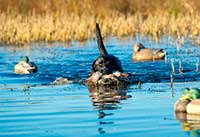 Check out Michigan's managed waterfowl areas for quality huntsHunters who have not been introduced to Michigan's Wetland Wonders - the DNR's managed waterfowl areas - have a unique opportunity to get to know five of them this year before duck season begins this fall. Open houses are scheduled for early October at the three Saginaw Bay areas, as well as at the Lake St. Clair and Lake Erie areas.
Check out Michigan's managed waterfowl areas for quality huntsHunters who have not been introduced to Michigan's Wetland Wonders - the DNR's managed waterfowl areas - have a unique opportunity to get to know five of them this year before duck season begins this fall. Open houses are scheduled for early October at the three Saginaw Bay areas, as well as at the Lake St. Clair and Lake Erie areas.
"The managed areas were really put together to provide high-quality waterfowl hunts in areas that would attract and hold ducks and geese," said Joe Robison, a wildlife biologist who supervises the five managed waterfowl areas in southeast Michigan. "That's what these areas were built for and that's what we're striving for.
"We manipulate water levels and provide balanced food sources," he continued. "We have crops of corn, buckwheat and millet, as well as good natural wild duck food - barnyard grass, wild millet and smartweed. And they're also all production areas, so we maintain prairie grass and nesting cover.
"You want to have a diversity of food, cover and water, and we've got that."
All managed waterfowl areas include refuge areas, where no hunting is allowed. Area managers conduct weekly surveys of refuges and post population estimates, as well as the habitat conditions, on the DNR website.
- Details
(Provided by Michigan DNR)
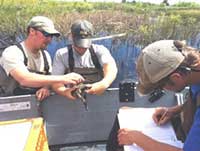 DNR Duck Banding Showcased on DiscoveringEfforts by a Michigan DNR crew to band ducks at the Portage Marsh in Delta County were showcased recently on an episode of "Discovering" a weekly outdoors program produced by Brian Whitens and broadcast at on WLUC-TV6, Marquette.
DNR Duck Banding Showcased on DiscoveringEfforts by a Michigan DNR crew to band ducks at the Portage Marsh in Delta County were showcased recently on an episode of "Discovering" a weekly outdoors program produced by Brian Whitens and broadcast at on WLUC-TV6, Marquette.
The duck banding was part of the DNRís goal to manage for sustainable populations of wildlife species. The DNRís objective is to manage game populations to provide hunting and trapping opportunities while maintaining populations in balance with available habitat, land use practices and stakeholder values.
- Details
(Provided by Michigan DNR)
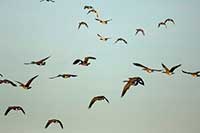 DNR brought Canada geese back from near extinction.It's no secret that Michigan offers some of the best Canada goose hunting anywhere in the world. But many waterfowl hunters, whose perspective only covers the last 30 years or so, might have a hard time believing it wasn't always that way. Michigan's resident Canada goose population - which produces the lion's share of the annual harvest ñ was virtually nonexistent a century ago and not especially noteworthy five decades later.
DNR brought Canada geese back from near extinction.It's no secret that Michigan offers some of the best Canada goose hunting anywhere in the world. But many waterfowl hunters, whose perspective only covers the last 30 years or so, might have a hard time believing it wasn't always that way. Michigan's resident Canada goose population - which produces the lion's share of the annual harvest ñ was virtually nonexistent a century ago and not especially noteworthy five decades later.
"Back in the '50s, it was a rare thing to see a Canada goose in this state," said Barbara Avers, the waterfowl specialist with the Michigan Department of Natural Resources. "It was rare for hunters to kill a goose. It was a pretty big deal.
"The restoration program has been exceptionally successful."
- Details
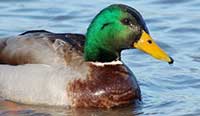 Could this be the year for duck hunters?Will this fall finally deliver waterfowl hunters the banner season theyve been expecting the past couple of years?
Could this be the year for duck hunters?Will this fall finally deliver waterfowl hunters the banner season theyve been expecting the past couple of years?
All the components are in place. Once again, nesting conditions have been superb in the North Country. Both ducks and geese populations are up.
But as Hoosier waterfowlers know all too well, it depends on the kind of weather Mother Nature hands us when the season opens Oct 24. She hasnt been very forgiving the past few seasons.
Indianas proposed season and bag limits set up similar to last year. Although the proposals require U.S. Fish and Wildlife approval, that likely wont be a problem.
- Details
(Provided by Michigan DNR)
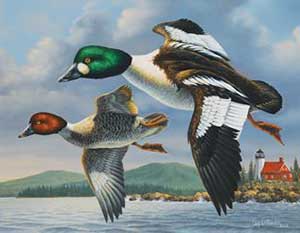 2015 collector-edition Michigan duck stampThe Michigan Duck Hunters Association, in cooperation with the Michigan DNR introduces the 2015 collector-edition Michigan duck stamp and prints.
2015 collector-edition Michigan duck stampThe Michigan Duck Hunters Association, in cooperation with the Michigan DNR introduces the 2015 collector-edition Michigan duck stamp and prints.
The Michigan Waterfowl Stamp Program, established in 1976, has become an icon for waterfowl hunters and wetland conservation enthusiasts. During the past 39 years, the program has gained popularity with collectors and conservation groups throughout the United States.
The Michigan Duck Hunters Association, a nonprofit organization dedicated to waterfowl and wetland conservation, coordinates the stamp program in partnership with the DNR. Proceeds from stamp sales will be used to fund Michigan Duck Hunters Association projects, with 10 percent used to match DNR funding for purchasing, restoring and enhancing wetlands.
The 2015 Michigan Duck Stamp features a striking pair of common goldeneyes in flight, painted by Guy Crittenden. Also featured on the stamp is the Eagle Harbor Lighthouse, located on Lake Superior in the Michiganís Upper Peninsula. Crittenden, a wildlife artist from Richmond, Virginia, has won the Virginia Duck Stamp Competition four times since 2005. He won the Connecticut Duck Stamp and the Michigan Duck Stamp competitions in 2014, and has placed as high as fifth in the prestigious Federal Duck Stamp Contest.




